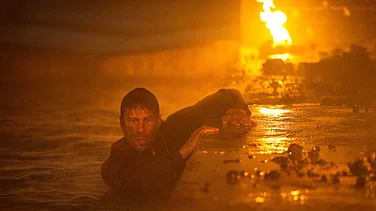Vinod Khanna, perhaps the handsomest of Indian film heroes, passed away recently. That weekend, if you had wanted to watch one of his iconic films—Achanak, Imtihan or Lekin, you would have drawn a blank on your recently-subscribed Netflix account. Amazon Prime, ditto. These films may be too art-house. You try Khanna’s more popular films: Khoon Pasina, Hera Pheri, Insaaf, Mere Apne, Mera Gaon Mera Desh, Dayavan. Nothing. There is not a single film of his on Netflix. Amazon Prime, yes, features about a dozen, but doesn’t show two of the actor’s most popular flicks: Amar Akbar Anthony and Qurbani.
Disappointment exists at the big-picture level as well. The streaming websites have almost nothing from India’s history of over 100 years of moviemaking. The country’s great auteurs are near-absent. No Ray or Ghatak, no Aravindan or Adoor, no Kasaravalli, no Bharathiraja, no Sai Paranjpye, no Gulzar, not even Mani Ratnam. “Where is the Indian content, or regional content?” asks Sabina Vij, a Punjabi cinema buff. At 50, she took to these platforms after persuasion from her children, but gave up and now makes them download her movies instead. Aditya Prakash, who loves his dose of Tamil cinema, is as disappointed. Netflix has just eight titles in his language!

Mere Apne no site offers any range of Indian films.
So, who are these people who in the dead of night go clip-clip-clappity-clip, the sound of millions ‘cutting the cord’? More and more sites are added every month; the fight of streaming supremacy is fierce. There are already half-a-dozen battling for the ‘iron throne’, sifting through the endless mass of online entertainment addicts to claim their next victim, well, subscriber—anyone who will care to pay. “These platforms target a younger audience more ready to experiment,” says Soumik Mukherjee, a filmmaker. The demographic sweet spot, he reckons, is in the 16-35 age group. So does the content on these platforms—original and otherwise—seem to point. “See, Hotstar has tied up with All India Bakchod, Amazon Prime Video with 13 other Indian comedians, and Netflix with Vir Das. These show they are all trying to cater to a certain younger audience,” says film buff Sushant Mishra, who is on all the new platforms. Netflix, to him, is the worst of the lot in its attempt to cater to Indians.
Even then, India is right now the hottest market. What started off with Star India’s digital entertainment platform Hotstar, dumping all its television content off the big screen to be “watched at ease”, picked up great speed with international biggie Netflix’s entry in the Indian market. With its ‘latest’ selection of international television shows and Hollywood movies, available legally without the download and virus hassles, the initial attraction of it was immense, and enough to lure other middle-rung players like Voot and TVF Play into the market. After that spike, the industry saw slow but steady growth.

A Delhiite watches a movie on Netflix
Netflix was the ruler of the pack until Amazon Prime Video came along. Launched last December; the online retailing giant has become a behemoth in the online entertainment industry as well. Industry trackers say Amazon Prime has, in less than four months, signed up 9.5 million active subscribers, vis-a-vis Netflix at 4.2 million. “The change in how people consume entertainment is a driving factor,” says Nitesh Kriplani, director and country head at Amazon Prime Video, India. With this has also come a change in the content that people want to view, he adds. “Amazon is not for young audiences alone. We will get rights of Indian films, old and new, if there is sufficient demand.”
TV is certainly not dead, not yet. But there is a bigger section opting for stories beyond the everyday soap operas. Take Balaji’s latest entry into this industry with AltBalaji. Known for her successful, and endless, saas-bahu dramas on television, the producer’s endeavour to tell shorter stories in different genres indicates changing trends. And the recent binge-watching addiction is a sure propeller for these platforms too. What these platforms best cater to is popular entertainment worldwide—not Indian, regional or independent content, but anything that is new or making news globally.

India is now the hottest market in online entertainment
“Buzz is in fact a major criterion for all these services,” says young Manuj Chawla, an early cable-cord cutter who has subscribed to Netflix, Amazon Prime Video and Hotstar. He gets his latest matches on Hotstar, and the rest on the other two platforms. Agrees Mayank Kharbanda, a chartered accountant who first came on Hotstar to binge-watch Game of Thrones and recently cut the cord himself: “See, everything that is doing the rounds internationally will be on Netflix, even if it is an independent exclusive like Court.” Hotstar, most believe, is best for live sports viewing and catching up with television off the big screen. It also has the biggest collection of Indian regional films—with 419 Telugu titles, 406 Kannada, 216 Bengali, and 875 Malayalam.
Original content too has slowly become a vital differentiator of this business. The service providers, who were earlier looking to deliver on the ‘latest and quickest’ formula keeping in mind the hard battle with illegal downloading in India, have realised that the strength lies in originals. “Even half-decent prints are easily available for download online, and legality is of little concern for a chunk of the eager, restless Indian population,” says Srishti Gupta, a marketing professional. While many viewers opt to download and watch later at their leisure, some are regular hoarders of content, who find it more appealing to download from any website that offers free content with decent quality. Also, most say downloading uses lesser data vis-vis streaming that requires higher bandwidth.
In such a scenario, entertainment platforms are turning to the production of original content to lure subscribers. Netflix has over 40 originals. Amazon is also into the game, with many originals slated to release soon—they say their Indian content will be a big draw even in this category. Hotstar’s recent launch of season two of the popular sitcom Sarabhai Vs Sarabhai has been a hit. “I began subscribing to Hotstar as soon as I heard of this show,” says Purnima Rajput, whose mother is a fan of recently released, Alt Balaji’s production Karle Tu Bhi Mohabbat. Most of these services are not highly priced, but are for a rounded experience. A subscription to multiple platforms can be pricey. Amazon Prime Video has a low entry threshold, with its current introductory offer of Rs 499 for a year; While Voot and TVF Play are still free, Hotstar has a monthly subscription of Rs 199. Alt Balaji’s launch offer is a mere Rs 30 a month.
Whatever be your drug of choice, the market has it, most agree. And the ‘buzz’ is palpable. The winding down of the cable market is evident, and most of the content there caters to an older audience. But by plying India’s youthful demographics with its hourly ‘fix’, online entertainment platforms are growing fast. Many youngsters no longer own a television set; these are the go-to options for their daily dose of entertainment. For others with bigger screens, smart televisions and easy television streaming devices such as Chromecast and now Amazon Fire have only enhanced the viewing experience.
All these entertainment platforms are increasingly looking to get ahead in the race to build a bigger army of subscribers. For that, like in most other businesses like fast food and fashion, they would have to ‘Indianise’ quickly. Hollywood and American TV series may be big, but India has its own thriving film and TV industry, in Hindi as well as all the other Indian languages. If a Netflix or Amazon Prime ignores this vibrant and diverse heritage, it could see its subscribers uninstalling them soon.


























